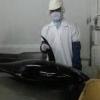Dear Charles,
Here, I repeat again for the way to define an OPRP & QCP
=> For OPRP
a. WHERE IT APPLIES => ON THE PRODUCT FLOW
b. SISTEMATICALLY, ON 100% OF THE PRODUCT => YES
c. ALLOWS THE PHISICAL ELIMININATION (DEFINITIVELY) OF THE HAZARD (= "NECESSARY & SUFFICIENT" CONDITION) => N.A
d. ALLOWS TO REDUCE THE PRESENCE OF THE HAZARD (= "NECESSARY BUT NOT SUFFICIENT" CONDITION) => YES
e. ALLOWS TO PUT INTO EVIDENCE / TO MEASURE THE PRESENCE OF THE RISK ITSELF => YES
f. THE RELATED MONITORING IS AIMED TO => CHECK THE CORRECT OPERATING CONDITIONS DURING THE PROCESS AND, IF ANY, THE RESULTS OF CONDUCTED OPERATION (eg.: quantity and quality of complaints, by-products, foreign materials, etc..)
g. OVERTAKING THE LIMITS AUTOMATICALLY GENERATES NON CONFORMING PRODUCT => N.A.
h. RECORDING OF MONITORING IS COMPULSORY => NO
i. RECORDING OF THE DECISION ABOUT THE NON CONFORMING PRODUCT IS COMPLUSORY => TO BE VERIFIED
=> For QCP
a. WHERE IT APPLIES => ON THE PRODUCT FLOW
b. SISTEMATICALLY, ON 100% OF THE PRODUCT => YES
c. ALLOWS THE PHISICAL ELIMININATION (DEFINITIVELY) OF THE HAZARD (= "NECESSARY & SUFFICIENT" CONDITION) => YES (for qualitative aspects)
d. ALLOWS TO REDUCE THE PRESENCE OF THE HAZARD (= "NECESSARY BUT NOT SUFFICIENT" CONDITION) => N.A
e. ALLOWS TO PUT INTO EVIDENCE / TO MEASURE THE PRESENCE OF THE RISK ITSELF => N.A
f. THE RELATED MONITORING IS AIMED TO => HAVE A DIRECT INTESITY MEASURE OF THE CRITICAL-FOR- THE- QUALITY DEFECT
g. OVERTAKING THE LIMITS AUTOMATICALLY GENERATES NON CONFORMING PRODUCT => YES.
h. RECORDING OF MONITORING IS COMPULSORY => YES
i. RECORDING OF THE DECISION ABOUT THE NON CONFORMING PRODUCT IS COMPLUSORY => YES
Sorry for incovenience before.
Regards,
Boedi
![]() , I need help for all of you.
, I need help for all of you.














